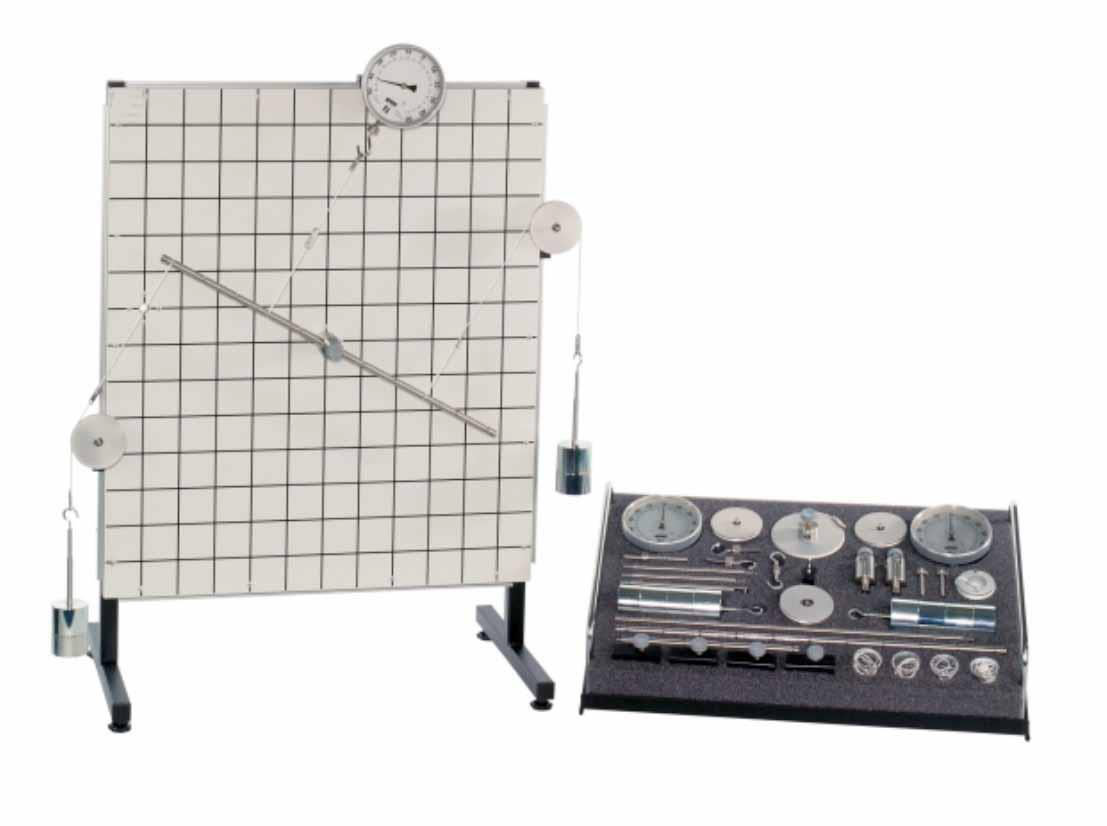Fundamentals of Statistics Model MT 108
Sci-tech Fundamentals of Static Apparatus Model MT 108 demonstrates fundamental principles of statics such as the equilibrium of forces and moments, resolution of forces, the laws of rigid body, the law of levers and beam and suspension of of cables demonstration.
The base element is an upright panel. Feet enable the panel to stand on a laboratory bench. All parts required for the experiment can be quickly attached to the rails around the edges. The imprinted line grid and grid-marked lever rods permit precise assembly. The lengths marked on the grid make it easy to define angles. A wide range of mountings, such as cables, rods, pulleys, torque disks, pivot bearings and the like, can be easily fixed in place and combined. Ball bearings integrated into the panel permit low-friction torque experiments. The versatility of the experimental unit helps students to explore their creativity in developing their own experiments.
Large-format force gauges are particularly well suited to demonstration purposes. The adjustable transparent dial enables input loads, such as dead-weights, to be taken into account.
Features
- Versatile experimental unit demonstrating planar mechanical force systems
- Scope of experimentation can be extended by supplementary sets
Sci-tech Fundamentals of Static Apparatus Model MT 108 demonstrates fundamental principles of statics such as the equilibrium of forces and moments, resolution of forces, the laws of rigid body, the law of levers and beam and suspension of of cables demonstration.
The base element is an upright panel. Feet enable the panel to stand on a laboratory bench. All parts required for the experiment can be quickly attached to the rails around the edges. The imprinted line grid and grid-marked lever rods permit precise assembly. The lengths marked on the grid make it easy to define angles. A wide range of mountings, such as cables, rods, pulleys, torque disks, pivot bearings and the like, can be easily fixed in place and combined. Ball bearings integrated into the panel permit low-friction torque experiments. The versatility of the experimental unit helps students to explore their creativity in developing their own experiments.
Large-format force gauges are particularly well suited to demonstration purposes. The adjustable transparent dial enables input loads, such as dead-weights, to be taken into account.
As a special teaching aid, it is possible to write directly on the panel with erasable markers. Markings, sketches and comments can be added to supplement the experiments. All parts are clearly laid out and well protected on a storage system. The storage systems are stackable, providing for space-saving storage.
Three supplementary sets are available to extend the scope of experimentation, providing additional experiments relating to the inclined plane, friction, pulley blocks and gear wheels.
- Experimental setup to demonstrate simple, planar force systems
- Panel with rails around the edges for easy mounting of various experimental components
- Panel with imprinted 50mm line grid and facility to write on using erasable marker
- Lever rods with 50mm grid
- Wide range of mountings: cables, rods, pulleys, torque disks, pivot bearings and the like
- Force gauges for tensile and compressive forces, with large-format display
- Transparent dial on force gauge rotatable
- Storage system to house all parts
- WxH: 600x700mm, @13kg
- Line grid: 50mm
- Measuring range: ±50N
- Display diameter: Ø=110mm
- Protected against overloading
- Roller chain
- Magnetic chain sprocket pulleys
- Spring balances
- Magnetic hook points
- Lightweight hooks
- Model ladder
- Magnetic pulleys
- Magnetic ladder hook and plate points
- Magnetic pulleys
- Cords with rings
- Rigid beam with hook points
- 2x 5N (hanger)
- 6x 5N
Accessories:
- Demonstration of Suspension Cable Model 108/01
- Analysis using catenary and parabola theory
- Cable weight and tension
- Comparison of a symmetrical suspension cable and catenary
- Unsymmetrical suspension cable
- A point load on a suspension cable
- Horizontal and vertical reaction forces on a ladder
- Safe angles for a ladder
- A climbing mass on a ladder
- A ladder at different angles
- Concurrent and non–concurrent coplanar forces
- An introduction to Bow’s notation and graphical analysis
- Force triangles, polygons and Link polygons
- Using moments and the theory of equilibrium to fi nd beam reaction and other unknown forces
- Simply-supported beams
- Balanced beams









